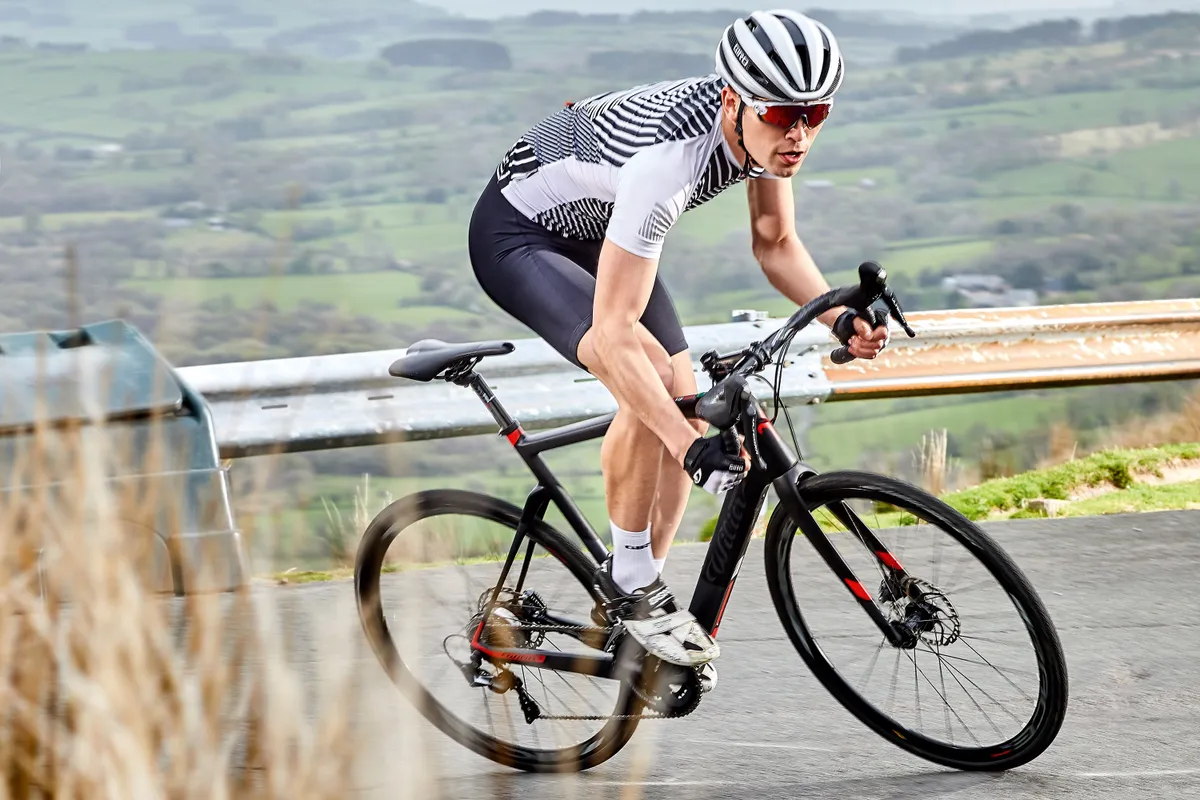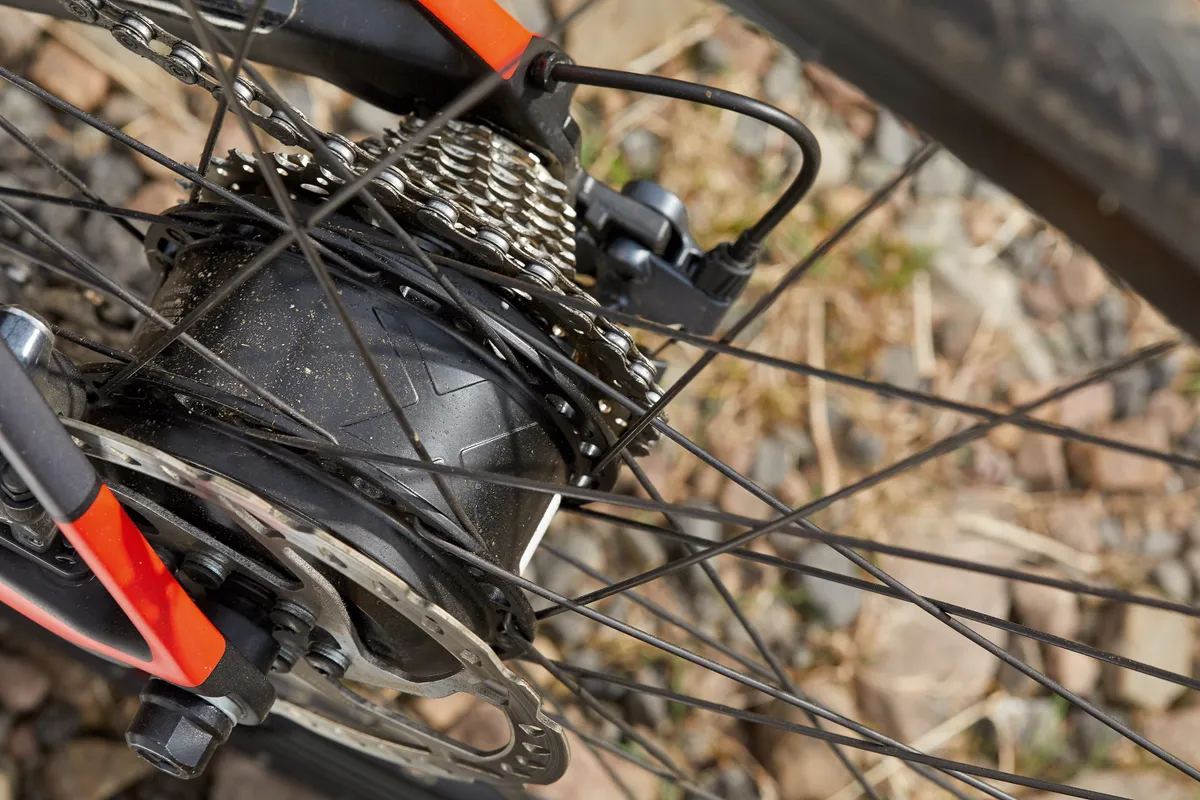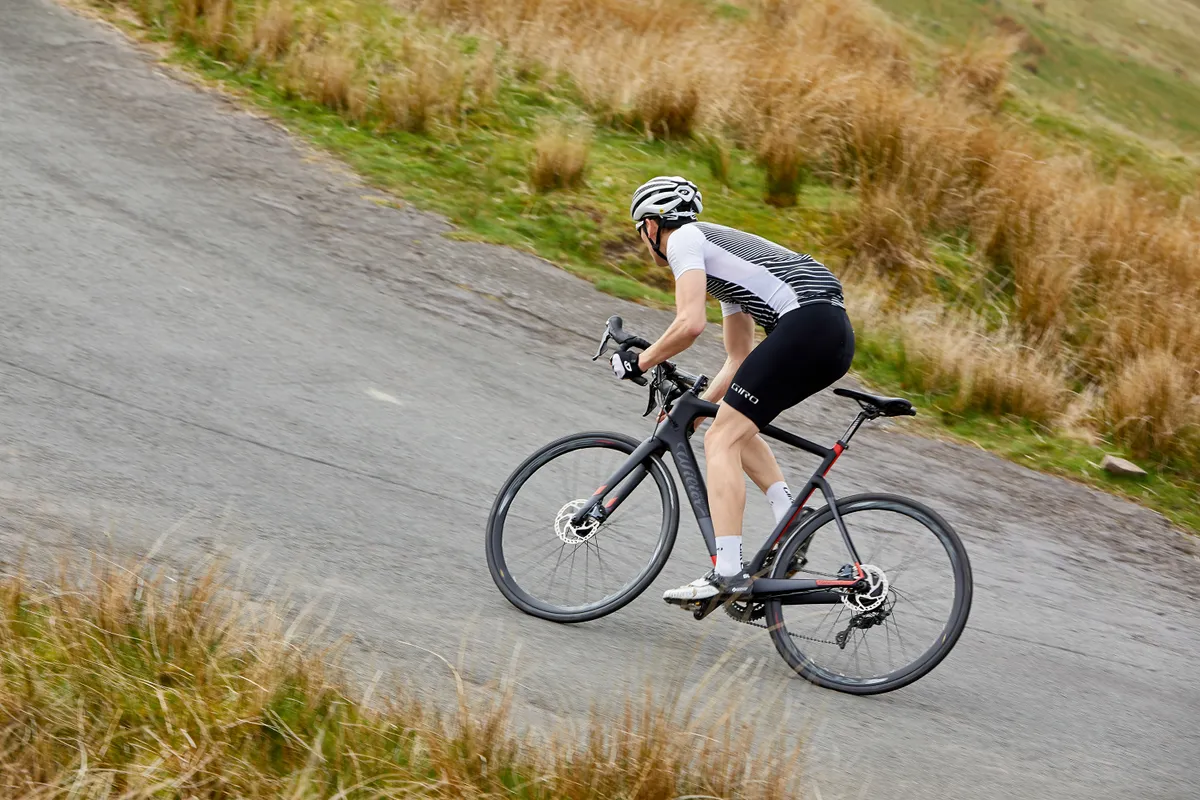The original Cento1 was Wilier’s all-round race machine in its SR form, reinvented with a smattering of aero as the Cento Air. It’s long been superseded as top dog in the Wilier hierarchy but it seems the firm wasn’t quite done with the Uno, because it’s now been adapted into an electrically assisted road bike – or a Hybrid as Wilier calls it.
The Cento1 retains the Uno’s good looks: the slimline frontal profile with its hourglass-shaped head-tube and deep bladed forks blends seamlessly into the main frame; at the back, the dropped seatstays are straight and slender.

Just because this is a Hybrid, don’t think Wilier has compromised on geometry. The stack (595mm) and reach (395mm) mark this out as a pretty racy bike.
The Cento1 Hybrid feels like a road bike and a good one at that. Yes, the weight (12.8kg) looks like a lot of mass, and the ebikemotion system (motor hub, wiring, controls, battery) accounts for 3.7kg of that. Compare that to the Bosch system on the Cannondale Synapse NEO SE or the Polini system on the Bianchi Impulso E-Road, and you’ll see that’s quite a saving.
The Orbea Gain, which was also on test, shares the same system but, thanks to me being able to up-spec on the MyO website, it comes in significantly lighter.
The ebikemotion is controlled by the iWoc button, flush-mounted into the top tube just behind the head tube. It’s impressively simple: press the button to turn it on and the LED-lit ring around the button shines white; press and hold and it flashes and turns green (low assistance), orange (medium) or red (full).
This also indicates the battery level: white (75–100 percent), green (75–50 percent), orange (50–25 percent), red (25–10 percent), flashing red (less than 10 percent). It’s Bluetooth enabled and flashes blue as it connects to your phone via the ebikemotion app.
The app shows a more accurate battery level, and you can ‘map’ the engine, along with distance travelled, altitude, average speed, cadence, gradient and current speed. You can even download maps and navigation and it will co-upload any recorded activities to Strava.
The ebikemotion system also works with a Bluetooth heart rate monitor. You can set your maximum heart rate so when you hit your threshold the system engages the motor at full power, giving you a respite and allowing your heart rate to return to normal.

Unlike the Bosch or Polini units, ebikemotion is an assist system. You can’t rely on the rear hub to drive you up a mountain – it’s more like a friend giving you a subtle (up to 250w) push. For less able riders, it’s the difference between getting to the top and walking.
I got consistent results with the Hybrid. On a hilly ride – remember the system cuts out at about 15.5mph – I did 62 miles (99.7793km) at an average of 17.1mph (27.5kph) with 998m (3274.28ft) of climbing. That compares to 76.7 miles (123.43km) with 1,222.2m (4009.84ft) of climbing on the Bianchi Aria-E I tested last month, but the weather conditions were better, and the Bianchi is half a kilo lighter.
I’d be tempted to spend more on a better set of wheels. The Ultegra Di2 version comes with the excellent Miche SWR carbon wheels
On further excursions I got 58 miles on a flatter ride and 53 miles where I relied more on e-assistance.
The Ultegra drivetrain is every bit as good as I’ve come to expect on non-assisted bikes, and the sensible 50/34, 11-32 gearing suits the bike well.
The extra weight means disc brakes are a must, and if you’re going to go disc then the Ultegra units here are ideal: bags of power, a great feel and no noise, despite being paired with non-Icetech rotors.
The Miche AXY-WP wheels are a fine mid-price option, with a rock-solid rim and tight build. They aren’t the lightest, though, and, because the motor is the rear hub, wheel choice on an e-bike is something you’ll be living with for a while.
So, while the Hybrid isn’t cheap, I’d still be tempted to spend more on a better set of wheels. (The Ultegra Di2 version comes with the excellent Miche SWR carbon wheels).
The Wilier branded stem by FSA is fine quality and the modest FSA Energy bar has the same great shape as its pricier cousins, with a flattened top section that offers a great optional hold.
The Selle Italia X1 saddle sits on top of a nice quality carbon seatpost, which is well shaped, although the vinyl cover can get a bit greasy and slippery when wet.

The extra weight compared to a conventional bike does affect the handling. The Cento now feels more suited to sweeping turns, and it’s very stable rather than nimble. The modest Miche wheels and middleweight tyres also dull the bike’s senses somewhat, especially when compared to the similarly equipped Orbea.
The front end feels much firmer than I remember on the original Cento and the chassis doesn’t seem to balance the added weight of the battery as well as the Orbea Gain. The generous tyres do take some of the sting out of the front end, though – and it’s not a wearing vibration from the front, more that it thumps its way through ruts and potholes making you grimace and worry about pinch punctures.
Wilier offers the Hybrid in a few build options, of which this is the most modest. It claims that the Cento1 Hybrid is the lightest e-road bike on the market and that may be so in its Dura-Ace Di2 and Miche SWR carbon-wheeled guise.
Wilier Cento1 Hybrid geometry (XL)
- Seat angle: 73 degrees
- Head angle: 72.5 degrees
- Chainstay: 41.1cm
- Seat tube: 51.5cm
- Top tube: 57.8cm
- Head tube: 18.5cm
- Stack: 59.5cm
- Reach: 39.5cm
Product
| Brand | Wilier_ |
| Price | A$9999.00, £4195.00, $5700.00 |
| Weight | 12.80kg |
Features
| Fork | Carbon |
| Frame | Carbon |
| Motor | ebikemotion |
| Tyres | Vittoria Zaffiro Pro 28c |
| Brakes | Shimano Ultegra disc |
| Cranks | Shimano Ultegra 50/34 |
| Saddle | Selle Italia X1 |
| Wheels | Miche Race AXY-WP with ebikemotion rear hub |
| Shifter | Shimano Ultegra |
| Cassette | Shimano Ultegra 11-32 |
| Seatpost | Wilier carbon |
| Available sizes | XS, S, M, L, XL |
| Rear derailleur | Shimano Ultegra |



